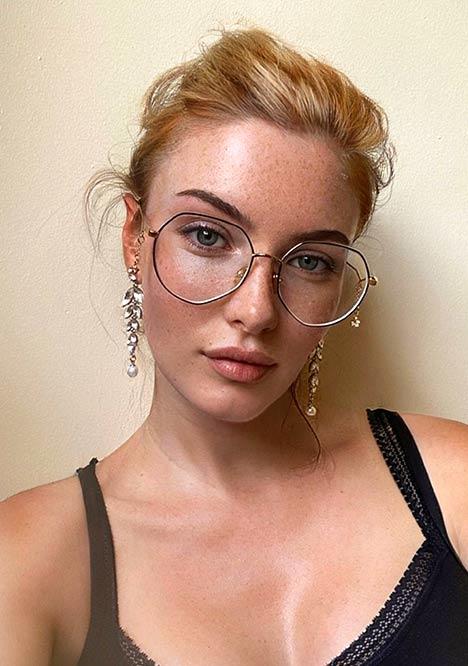Bifocal glasses explained: how do they work?
Vision changes are a part of the aging process, which often requires corrective eyewear like bifocal glasses. If you find it hard to read up close and see objects from afar, you likely must wear these eyeglasses. Here is everything you should learn regarding bifocals and whether you need one.

What are bifocals and how do they work?
In essence, bifocal eyeglasses are two-in-one prescription eyewear. This type of glass comprises two lens powers offering optical correction for long and short sight distance. Typically, the lower half of the lens is for the reading prescription. The upper half, on the contrary, is reserved for long-distance vision. However, the segments may vary depending on the requirements of the wearer.
Bifocals help correct presbyopia, a condition that occurs when the eye's lenses lose their flexibility. When the lens becomes less pliable, the eye finds it harder to focus its sight at different distances. Objects may appear blurry, and there is an overall difficulty in seeing. This eye issue is common among the older population.
How it works
Bifocal glasses compensate for presbyopia or the natural degradation of one's vision because of aging. In general, the lenses are divided into two segments, each with varying sizes and shapes. For example, they can have a D-segment (also known as half-moon or flat-top), a round segment, or a ribbon segment. These portions refer to the near-vision correction usually found on the lower half of the lens.
The wearer can focus on objects at a faraway point using the distance segment of the lenses. Since this portion is typically on the upper half, the user only has to look up and through the glasses. When focusing on reading materials, the wearer looks down and through the lower segment specifically designed for this purpose.
Can we wear bifocals all the time?
Eye care experts advise people who use bifocals for the first time to wear them regularly until they can adjust their line of sight. For instance, if you switch from regular glasses to bifocal eyeglasses, you will likely need an adjustment period for it. Basic activities like driving or climbing stairs can look and feel different with this type of glasses on.
That said, the most imminent change you need to get used to is switching between the two segments. Say you are driving with your bifocal glasses on. If you want to check your gas gauge or speedometer, you must look through the lower bifocal segment. For road navigation, you should adjust your sight to focus on the upper portion of the lenses.
Which is better: bifocal or progressive lenses?
Based on function, both bifocal and progressive glasses allow you to fit two prescriptions (near to far) in one lens. These eyeglasses help you see your best at all distances without needing to swap between two eyewear. You can comfortably go about your daily activities without worrying about your vision problems with these glasses.
The main difference between both glasses is the distinction between far and near prescriptions. For bifocals, there is a visible line separating the segments, while progressive lenses offer a seamless transition. This difference is the reason why the best option depends on the wearer. You should consider your lifestyle and preference when choosing between bifocal glasses and progressive lenses.
How to find the right bifocal glasses?
Bifocals look like your ordinary eyewear except for the thin line distinguishing the vision zones. Still, it's better to select a pair that suits you best. One factor to consider is the type of lens, such as flat-top, round segmented, or executive bifocals. These categories describe the design of the bottom portion, which allows you to see nearby objects clearly.
Besides selecting the best lens to improve your vision, you should also consider the overall aesthetic of the frame. That includes picking the right shape that enhances your facial features. For instance, round glasses fit people with sharp jawlines and angles. Square glasses or rectangle eyeglasses are more suitable for people with round-shaped faces.
Ultimately, your preference is the best guide when buying bifocals. You need to purchase a frame that is comfortable to wear and can enhance your features. As for the lens, you can talk to your eyecare expert regarding the best type of bifocal glasses that will work best for you. Check out the selection at Lensmart today for trendy and classic frames at affordable prices that you will love!
Best bifocal glasses for men & women
1. Elora

Featuring a trendy tortoiseshell frame, the Elora glasses offers a classic and stylish aesthetic. The exquisite cat eye frame and tortoiseshell pattern carefully integrated into the one frame, adding a touch of finesse to the overall appearance.
2. Filippo

This Filippo glasses has a modern and stylish design, with a focus on the color combination of yellow and navy. The frame is navy on its front, but it features the vibrant yellow that runs along the inside and temple arms, giving it a pop of color and an eye-catching look.
3. Rowan

This Rowan glasses is crafted with the fine color of ebony, showcasing a distinct and elegant pattern. The glasses, in its aviator frame, enjoys a classic design that screams timeless fashion. The zebrano pattern also adds a touch of uniqueness to the glasses, making it a standout pair.
Read More:
Bifocal lenses explained: advantages & disadvantages
What are of trifocal lenses advantages and disadvantages
How do varifocal lenses work? Pros, cons, and more
Bifocal reading glasses explained: what is the best pair?
Ultimate guide to choosing the best frames for glasses
All types of prescription lenses explained
How to adjust to bifocal and progressive glasses?
Bifocal vs. progressive lenses: which are better for you?



















